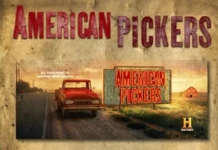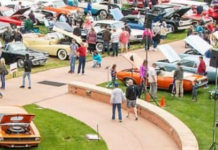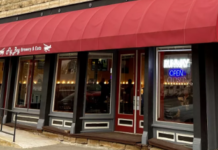From the Office of Public Affairs | http://www.news.ku.edu
Headlines
Mexican American fast-pitch community, culture chronicled in new book
LAWRENCE — A new book by a University of Kansas associate professor of American studies explores the rich history of Mexican American fast-pitch softball, where teams rooted in friendship and family relations represent community. Ben Chappell traveled to tournaments throughout the central United States, including in Kansas, for “Mexican American Fastpitch: Identity at Play in Vernacular Sport” (Stanford University Press).
Visual art professor’s new KC exhibition explores sense of body, queer identity
LAWRENCE — A University of Kansas associate professor of visual art has a new show titled “And the band played on, and on on,” which runs through Sept. 24 in the front gallery of Studios Inc. in Kansas City, Missouri. “This work has subtle and suggestive references to the queer experience in image, material and language — and sometimes not so subtle,” said Ben Rosenthal, whose exhibition is the culmination of a multiyear residency with the nonprofit studio.
KU Libraries, Spencer Museum present exhibition highlighting work of Kansas artist and art therapist Mary Huntoon
LAWRENCE — The University of Kansas Libraries, in collaboration with the Spencer Museum of Art, will open a new exhibition in Kenneth Spencer Research Library on Aug. 23. “Mary Huntoon: Artist & Art Therapist,” curated as part of a major conservation initiative supported by the Andrew W. Mellon Foundation, shines a light on a Kansas native whose art brightened the lives of many.
Full stories below.
————————————————————————
Contact: Jon Niccum, KU News Service, 785-864-7633, [email protected]
Mexican American fast-pitch community, culture chronicled in new book
LAWRENCE — The Kansas City Amigos. The San Antonio Glowworms. The Omaha Mestizos.
While these names may not mean much to fans of the Boston Red Sox or Chicago Cubs, they are revered by those who follow Mexican American fast-pitch softball.
“What differentiates this tradition is it was born out of segregation,” said Ben Chappell, associate professor of American studies at the University of Kansas.
That history is explored in his new book, “Mexican American Fastpitch: Identity at Play in Vernacular Sport” (Stanford University Press). In this multi-sited ethnography, Chappell conveys the importance of the sport within the culture of Mexican American communities. Chappell traveled to tournaments throughout the central United States, interviewing players and striking up conversations in the bleachers while documenting the intense rivalry of competition and brotherly spirit of the game.
“The story I’m telling is one that has roots in the 1930s and ’40s, when softball was one of the most popular recreations in the entire country,” he said. “The New Deal funded tons of softball fields. A lot of cities had public parks with softball equipment, so kids didn’t even have to have gear — they could just go check it out and play. All of that was fastpitch.”
As he writes in the book, fast-pitch softball (differentiated by hard-throwing underhand pitches) is now dominated by women’s collegiate teams. But the portrait that emerges of Mexican American fastpitch involves “people who have endured migration, limited economic opportunity, de facto segregation and everyday racism but also have gained a degree of social mobility over time, forming fast-pitch teams rooted in friendships and family relations along the way.”
Chappell went to nearly 20 tournaments (primarily in Kansas and Texas) while researching the book. He noted how participation has visibly declined somewhat during the last decade.
“Players would tell me, ‘It’s a dying sport because the kids only want to do soccer.’ Or, ‘We can’t get the fields because all the hipsters want to play kickball,’” he said.
In response, the longest-running tournament, which takes place in Newton and is now in its 73rd year, attempted to recruit more players by inviting several Indigenous American teams. One such team from Oklahoma named the Big Eagle Express actually won last year’s tourney.
Fortunately, there is evidence that suggests a resurgence. This summer, the Newton tournament showcased 17 teams, its highest total in years.
“Part of my intervention with the book is to say we need to focus on sport the way it’s played at the community level,” Chappell said.
“Within academic sports studies, there’s a lot of work done on Major League Baseball or the Olympics – athletics performed at the elite level. But my point is that only reflects a very small slice of humanity, and for many more people, sport is something you play or watch your kids play.”
That’s why he used the word “vernacular” in the subtitle of the book.
“Vernacular is a word that refers to the language people actually speak face to face, and I’m trying to reclaim that concept to talk about the everyday level of sports,” he said. “It’s the level of interaction where the players and the fans are very close to each other. There is kind of a gray line between watching and participating, and it’s something truly embedded in the everyday life of the community.”
Chappell said he’s drawn to the premise that individuals who find themselves in tough situations frequently do creative things. This was the impetus for his previous book, “Lowrider Space: Aesthetics and Politics of Mexican American Custom Cars” (2012, University of Texas Press).
“People in these communities often ask, ‘How are we going to survive here? How are we going to be Mexican in the United States? How are we going to deal with segregation and with being treated as foreigners, when we’re not?’” he said.
“Both lowriders and softball are ways people have creatively responded to that. ‘We’re going to play the game everybody’s playing, but we’re going to really identify that this is our team, our community, our tradition.’”
A KU faculty member since 2007, Chappell hopes “Fastpitch” helps establish the sport as a legitimate academic topic.
He said, “I will consider this book a success if it’s ever the case that some school kid needs to do a research project and finds it in the library. And then the kid’s able to say, ‘Oh, that thing my grandpa did really meant something!’”
-30-
————————————————————————
The official university Twitter account has changed to @UnivOfKansas.
Refollow @KUNews for KU News Service stories, discoveries and experts.
Tweets by KUnews
———————————————————————-
Don’t miss new episodes of “When Experts Attack!,”
a KU News Service podcast hosted by Kansas Public Radio.
https://kansaspublicradio.org/when-experts-attack
————————————————————————
Contact: Christy McWard, KU Libraries, 785-864-0092, [email protected], @KULibraries; Elizabeth Kanost, Spencer Museum of Art, 785-864-0142, [email protected], @SpencerMuseum
KU Libraries, Spencer Museum present exhibition highlighting work of Kansas artist and art therapist Mary Huntoon
LAWRENCE — The University of Kansas Libraries, in collaboration with the Spencer Museum of Art, will open a new exhibition in Kenneth Spencer Research Library on Aug. 23. “Mary Huntoon: Artist & Art Therapist” features collection objects from both KU Libraries and the Spencer Museum.
The exhibition, curated as part of a major conservation initiative supported by the Andrew W. Mellon Foundation, shines a light on Mary Huntoon, a Kansas native whose art brightened the lives of many. The libraries and the museum are home to a large collection of original artwork by Huntoon, as well as the Mary Huntoon papers, which include personal and business correspondence, original poetry manuscripts, photographs and more. Many of the original works of art have undergone conservation treatments in preparation for their exhibition debut.
“Mary grew up knowing she wanted to be an artist,” said Jacinta Johnson, associate paper conservator for the Mellon initiative. “She studied at The Art Students’ League in New York and lived in Paris for five years. She returned to Kansas in 1930 and later became one of the early pioneers of what is now art therapy. Her work depicts important people in her life and all the different places she lived and the places she traveled.”
The exhibition will explore Huntoon’s career in three sections, focusing on her artwork, her efforts in the field of art therapy and the conservation work Johnson completed on Huntoon’s artwork and papers.
In 2018, KU Libraries and the Spencer Museum earned a significant grant from the Mellon Foundation to conserve valuable cultural materials housed at the University of Kansas. Dedicated to this effort, Johnson supports both campus units and seeks out connections between their collections. She curated the Huntoon exhibition in collaboration with Spencer Research Librarian Letha Johnson and Spencer Museum Curator Kate Meyer.
In addition to the exhibition, the libraries and the museum will host two related virtual events.
1. Sept. 21, 6 p.m.: “The Place of Kansas in the Evolution of Art Therapy,” with Libby Schmanke, professor with the Emporia State Art Therapy Program
2. Sept. 27, 7 p.m.: “Mary Huntoon’s Unexpected Legacy,” with Christina Weyl, researcher of women printmakers
“Mary Huntoon: Artist & Art Therapist” will be on display in Spencer Research Library through Nov. 23. A virtual exhibition will build on the collections and research presented in person. Learn more on the KSRL webpage.
Kenneth Spencer Research Library is located at 1450 Poplar Lane, directly behind Strong Hall and across from the Campanile. All are welcome to visit the exhibition during current hours of operation, which can be found on the Spencer Research Library website.
-30-
————————————————————————
KU News Service
1450 Jayhawk Blvd.
Lawrence KS 66045
Phone: 785-864-3256
Fax: 785-864-3339
[email protected]
http://www.news.ku.edu
Erinn Barcomb-Peterson, director of news and media relations, [email protected]
Today’s News is a free service from the Office of Public Affairs




